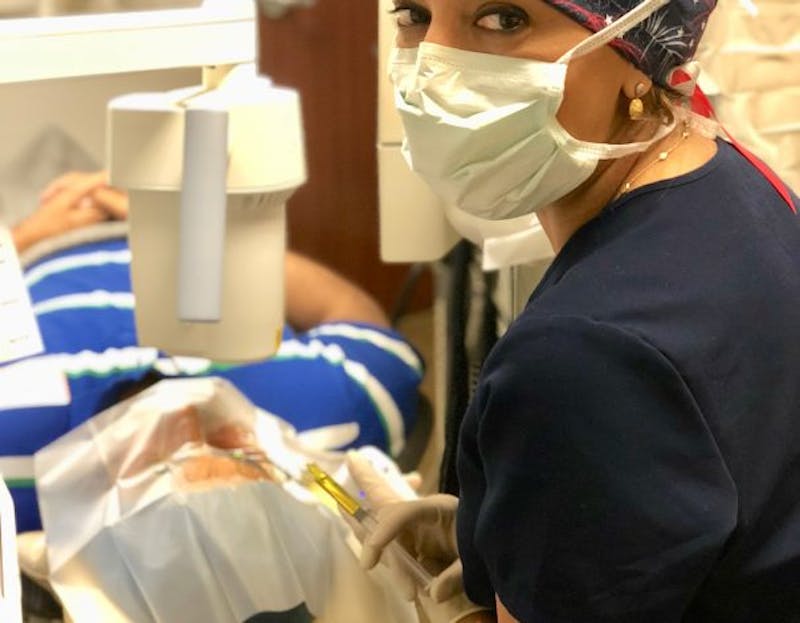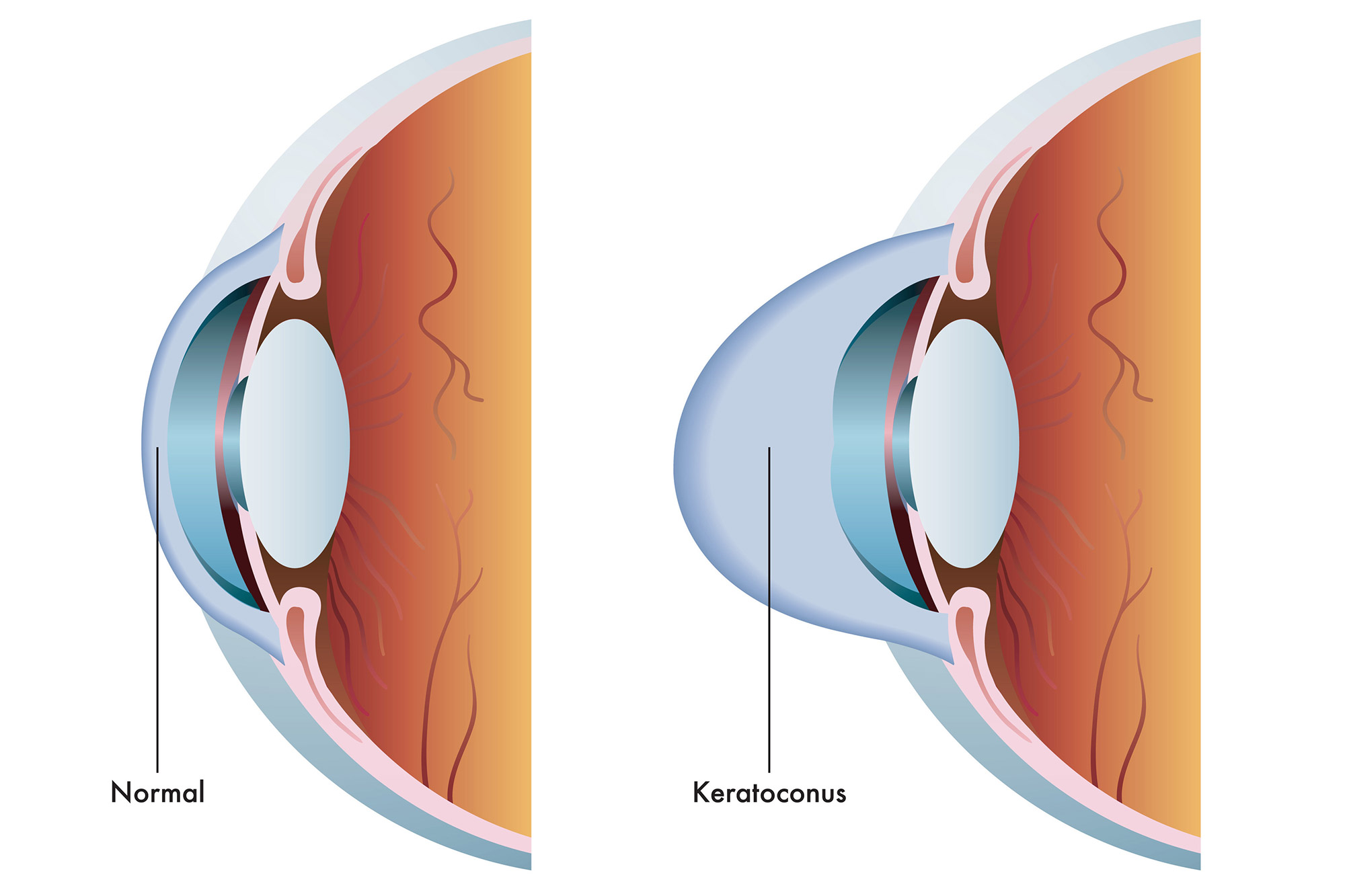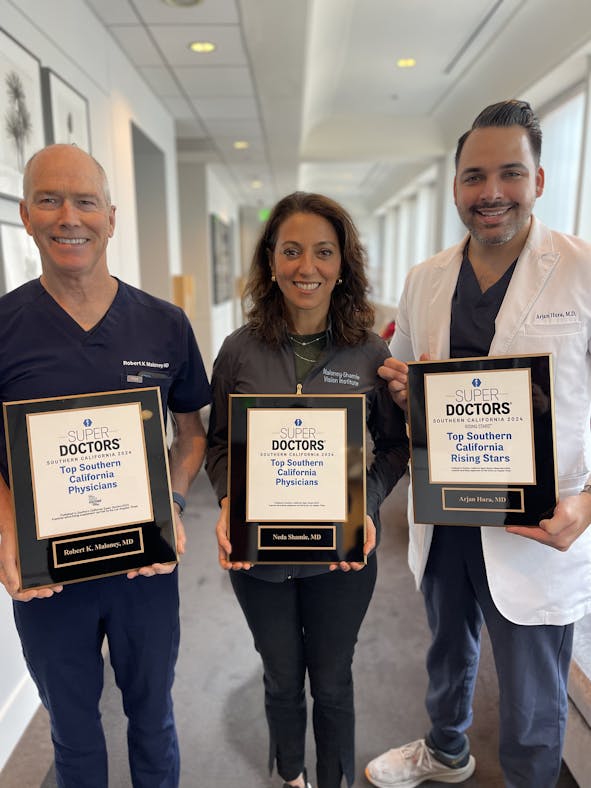Schedule a Consultation
Life Clarity Focus
Contact UsPasadena Location Now Open

Corneal collagen cross-linking is a technique that was first used in 1998 to treat patients with a disease called keratoconus. In keratoconus, the cornea (the front clear window of the eye) can become weak, thin, and irregularly shaped. Instead of keeping its normal round shape, corneas with keratoconus can bulge forward into the shape of a cone causing poor vision.
What is keratoconus?
Keratoconus is a common disease that occurs in approximately 1 in 750 Americans. In this condition, the cornea becomes weak, progressively thinner, and irregular in shape which can cause high levels of astigmatism. Instead of a normal, relatively round shape resulting in clear vision, the cornea in keratoconus can become cone shaped. This can interfere with the ability to see clearly. Often keratoconus patients first require glasses, then contact lenses, and, if the condition progresses to a severe level, a corneal transplant may be required.

What is astigmatism?
Astigmatism means that the front surface of the eye (the cornea or clear window in front of the eye) is less round and more irregular in shape so the image won’t focus clearly on the retina in the back of the eye. This can result in poor vision and glare.
What does CXL do?
Normal corneas have crosslinks between its collagen fibers that keep it strong and able to retain its normal shape. In keratoconus, the cornea is weak with too few cross-links or support beams. This weakened structure allows the cornea to bulge outwards. The cross linking procedure adds cross-links or “cross beams” to the cornea, making it more stable, holding its shape and focusing power better. These new cross-links help strengthen the cornea which stops the thinning process and further loss of vision.
CXL works by adding “crossbeams” between the weak layers of the cornea in keratoconus eyes.
Can CXL be performed for everyone with keratoconus?
To qualify for CXL, patients must be at least 14 years old and their corneas cannot be too thinned or too scarred for the procedure. During your consultation, Dr. Shamie will determine if CXL might be an option for you.
Should your relatives be tested?
As you may know, keratoconus is a condition that often runs in families, so it’s important to arrange a screening for all family members of patients with keratoconus. If caught early, there is a good chance that CXL can halt the progression of keratoconus and prevent the need for uncomfortable contact lens wear and/or corneal transplant.
How effective is CXL?
Many research studies have shown that CXL may prevent further vision loss in over 95% of patients and improves vision in 60-81% of patients treated.
Is CXL like LASIK?
No. LASIK is a procedure that reduces or, in some cases, may even eliminate the need for glasses or contact lenses by removing corneal tissue. The CXL treatment does not remove tissue. The purpose of CXL is to prevent further deterioration of vision for most patients and to potentially improve vision. Patients will typically require a lower eyeglass prescription or can have an easier time being fit with contact lenses.
Can CXL prevent the need for corneal transplant?
Many studies have shown that CXL can often prevent the need for a corneal transplant and allow patients to wear contact lenses or glasses more comfortably and safely again.
Can a corneal transplant be done after CXL?
If CXL does not prevent the need for a corneal transplant, then a corneal transplant can generally be performed.
Can I have CXL if I already had a corneal transplant?
Each patient and each patient’s eyes are different. In some cases CXL can be performed after corneal transplantation.
What’s the difference between a corneal transplant
and CXL?
CXL is an in office procedure that does not involve surgical incisions into the eye or stitches. It is a relatively non-invasive procedure that is done with vitamin drops and light. Corneal transplants are performed in an operating room, involving incisions into the eye and a lifelong risk of rejection of the corneal tissue.
How long does CXL treatment last?
Based on CXL study results over more than a decade, the beneficial effects of CXL appear to last for many years and there is evidence that this strengthening effect may be permanent.
Is CXL new?
Corneal collagen cross-linking has been performed since 1999. The results and safety profile of CXL have been very positive in numerous studies throughout the world. In fact, by September of 2006, CXL had been approved by all 25 European Union nations. CXL procedures are now routinely performed on patients as young as 10 years old in Europe to prevent the development of keratoconus.
Does CXL need to be repeated?
In many studies, the majority of patients responded to a single vitamin and light CXL treatment and did not needto have the procedure repeated. CXL can often be repeated when treatment is not effective.
How is CXL performed?
The CXL treatment is an outpatient procedure performed in the our office using only numbing eye drops and a mild sedative like a Valium tablet. You’ll need to lie flat on your back in a reclining chair and look up at a soft blue light during the treatment. The epithelium, a thin layer of clear, protective tissue (like skin) that covers the cornea is removed for the CXL procedure. Next, vitamin eye drops (riboflavin) are used in the eye and you will be asked to look at a special blue (ultraviolet) light while lying comfortably on a reclining chair. It’s generally easy to look at this light because your eyes are numb and we use drops so your eyes won’t feel dry.
How long does the procedure take?
If two eyes are being treated at once, the procedure takes approximately an hour and a half. If only one eye is being treated at a time, the procedure takes approximately one hour.
Does the CXL procedure hurt?
No. The cross-linking procedure is painless. Anesthetic eye drops are used to avoid any discomfort during the procedure.
When is the best time to have CXL?
As with most conditions, prevention of a problem is better than treatment of a problem. The best time to treat keratoconus is before astigmatism has become severe and vision has been lost. This does not mean that people with very poor vision from keratoconus cannot be helped by CXL. However, the results of CXL for patients with advanced keratoconus have not been as good as for patients with early disease.
Will I need new glasses or contacts after CXL?
Because cross-linking often improves vision, patients find that their old contacts or glasses are too strong for them and they need to be refit with new, glasses and/or contact lenses. Most of the time, patients can wear their old glasses until several months after the procedure when your regular eye doctor will prescribe new ones. Because the effects of CXL occur slowly, patients don’t generally have to change their glasses very often.
When will I notice any improvement in my vision after CXL?
With the traditional CXL procedure, most patients find that immediately after the cross linking treatment, their vision is actually worse than it was before the procedure. This usually goes on for roughly 3-6 weeks. Patients may start to notice positive effects 4-8 weeks after the procedure and may experience major improvement in vision at least 3-6 months after the investigational procedure. In some studies patients’ vision and astigmatism were still continuing to improve five years after the cross-linking procedure so visual improvement is a long process.





© Maloney-Shamie-Hura Vision Institute. All Rights Reserved.